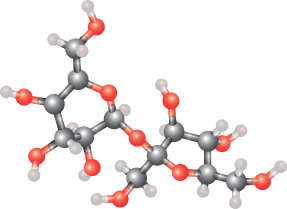
Back سكر ثنائي Arabic Disaxarid Azerbaijani Дыцукрыды Byelorussian Дыцукрыды BE-X-OLD Дизахарид Bulgarian দ্বি-শর্করা Bengali/Bangla Disaharidi BS Disacàrid Catalan دی ساکارید CKB Disacharidy Czech

A disaccharide (also called a double sugar or biose)[1] is the sugar formed when two monosaccharides are joined by glycosidic linkage.[2] Like monosaccharides, disaccharides are simple sugars soluble in water. Three common examples are sucrose, lactose, and maltose.
Disaccharides are one of the four chemical groupings of carbohydrates (monosaccharides, disaccharides, oligosaccharides, and polysaccharides). The most common types of disaccharides—sucrose, lactose, and maltose—have 12 carbon atoms, with the general formula C12H22O11. The differences in these disaccharides are due to atomic arrangements within the molecule.[3]
The joining of monosaccharides into a double sugar happens by a condensation reaction, which involves the elimination of a water molecule from the functional groups only. Breaking apart a double sugar into its two monosaccharides is accomplished by hydrolysis with the help of a type of enzyme called a disaccharidase. As building the larger sugar ejects a water molecule, breaking it down consumes a water molecule. These reactions are vital in metabolism. Each disaccharide is broken down with the help of a corresponding disaccharidase (sucrase, lactase, and maltase).
- ^ "Biose". Merriam-Webster.
- ^ IUPAC, Compendium of Chemical Terminology, 2nd ed. (the "Gold Book") (1997). Online corrected version: (2006–) "disaccharides". doi:10.1351/goldbook.D01776
- ^ Kwan, Lam Peng (2000). Biology- A course for O Level. p. 59. ISBN 9810190964.
© MMXXIII Rich X Search. We shall prevail. All rights reserved. Rich X Search